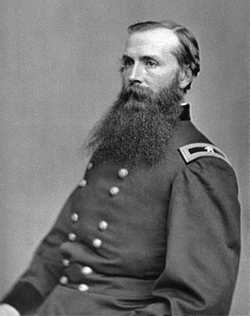Charles K. Graham facts for kids
Quick facts for kids
Charles Kinnaird Graham
|
|
|---|---|
 |
|
| Born | June 3, 1824 New York City, New York |
| Died | April 15, 1889 (aged 64) Lakewood, New Jersey |
| Place of burial |
Woodlawn Cemetery, The Bronx, New York
|
| Allegiance | United States of America Union |
| Service/ |
United States Navy United States Army Union Army |
| Years of service | 1841–1848 (Navy) 1861–1865 (Army) |
| Rank | |
| Commands held | 74th New York Infantry 2nd Brigade, 3rd Division, III Corps 1st Brigade, 1st Division, III Corps 3rd Division, III Corps (temporary) Naval Brigade, XIII Corps |
| Battles/wars | Mexican–American War American Civil War |
Charles Kinnaird Graham (born June 3, 1824 – died April 15, 1889) was an important American figure. He was a sailor in the United States Navy before the American Civil War. Later, he became a lawyer and a high-ranking officer, a brigadier general, in the Union Army during the Civil War. Before his military service, he was a civil engineer. He even helped design and create Central Park in New York City.
Contents
Early Life and Education
Charles Kinnaird Graham was born in New York City. When he was 17, in October 1841, he joined the Navy. He served as a midshipman, which is a junior officer in training. He was part of the Navy in the Gulf of Mexico during the Mexican–American War. He left the Navy in May 1848.
After his time in the Navy, Graham studied engineering. From 1857, he worked as a construction engineer. One of his big projects was at the Brooklyn Navy Yard. During this time, he also served in the New York Militia. He rose through the ranks, becoming a major, then a lieutenant colonel, and finally a colonel.
Fighting in the Civil War
When the American Civil War began, Charles Graham joined the Union Army. This was on May 26, 1861. He became a colonel, leading the 74th New York Volunteer Infantry Regiment. This regiment was part of a famous group called the "Excelsior Brigade."
He briefly left the army but returned in May 1862. He rejoined his regiment during the Peninsula Campaign. In November 1862, he was promoted to brigadier general. This meant he was a general in charge of many soldiers. He then commanded a brigade, which is a large group of troops.
Key Battles
Graham fought in some very important battles:
- Battle of Chancellorsville: In this battle, he commanded a brigade. When another general was badly hurt, Graham temporarily took command of a larger group of soldiers, a division.
- Battle of Gettysburg: This was one of the most famous battles of the war. Graham's brigade bravely defended a key Union position. This area was near a place called the Sherfy peach orchard. During the fighting on July 2, he was wounded in his hip and shoulders. He was captured by the Confederate forces.
Prisoner of War and Later Service
After being captured at Gettysburg, Graham was sent to a prison camp. This camp was in Richmond, Virginia. He was held there until September 19, 1863. He was then part of a prisoner exchange, where he was traded for a Confederate general.
Once he recovered from his injuries, Graham was given a new command. He led a group of gunboats on the James River. This group was called the "Naval Brigade." He led them in the First Battle of Fort Fisher. This was a major battle to capture a strong Confederate fort.
After this battle, Graham commanded the defenses of Bermuda Hundred, Virginia. Later, he was in charge of the soldiers in Norfolk, Virginia. He left the volunteer army on August 24, 1865.
In 1866, President Andrew Johnson honored Graham. He nominated him to be a brevet major general. This was an honorary promotion for his brave service. The United States Senate confirmed this honor.
Life After the War
After the Civil War ended, Charles Graham went back to New York. He continued his work as a civil engineer. From 1878 to 1883, he worked as the surveyor for the port of New York. This meant he was in charge of mapping and inspecting the port.
Charles Kinnaird Graham passed away from pneumonia on April 15, 1889. He died in Lakewood, New Jersey. He was buried in Woodlawn Cemetery in The Bronx, New York City.
Images for kids


